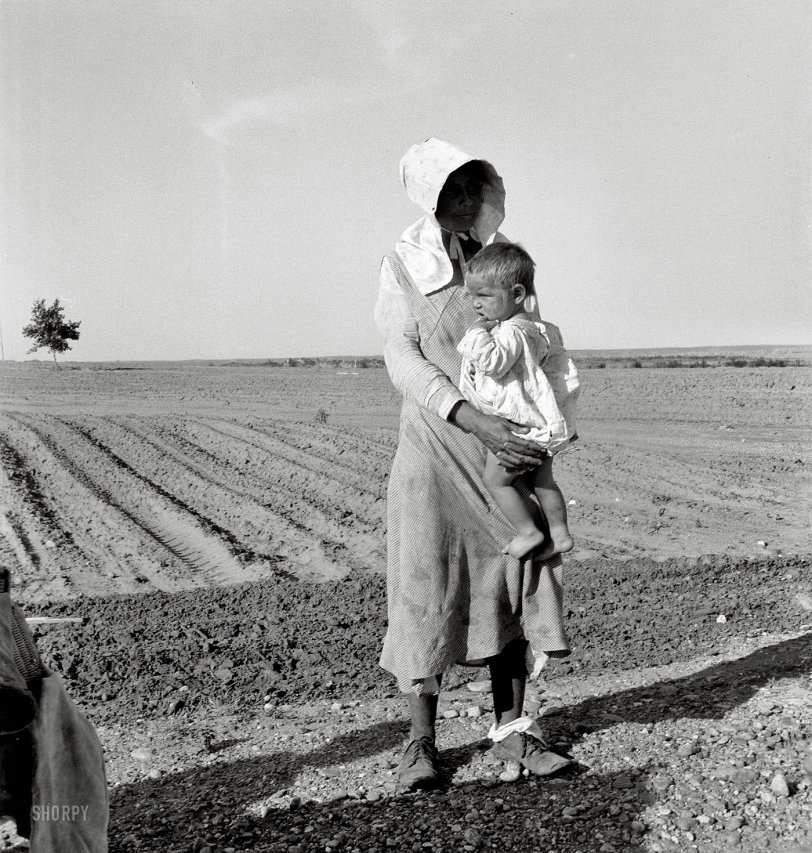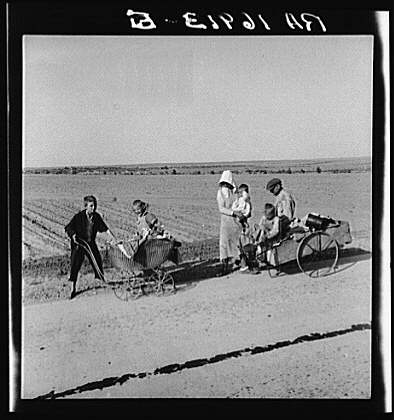


Framed or unframed, desk size to sofa size, printed by us in Arizona and Alabama since 2007. Explore now.
Shorpy is funded by you. Patreon contributors get an ad-free experience.
Learn more.

- Exclusive pump
- Details, Details
- What's that building to the left of the tower?
- Coal Barges
- Bromo-Seltzer
- Inner harbor
- The Basin
- What a headache!
- Giant stepladder?
- Baldwin 62303
- Baldwin VO-1000
- Cold
- No expense spared
- Tough Guys
- Lost in Toyland
- And without gloves
- If I were a blindfolded time traveler
- Smoke Consumer Also Cooks
- Oh that stove!
- Possibly still there?
- What?!?
- $100 Reward
- Freeze Frame
- Texas Flyer wanted
- Just a Year Too Soon
- WWII -- Replacing men with women at the railroad crossing.
- Yes, Icing
- You kids drive me nuts!
- NOT An Easy Job
- I wonder
Print Emporium
The Wayfarers: 1937

May 1937. "Mother and child of Arkansas flood refugee family near Memphis, Texas. These people, with all their earthly belongings, are bound for the lower Rio Grande Valley, where they hope to pick cotton." Medium-format nitrate negative by Dorothea Lange for the Resettlement Administration. View full size.
Cotton Fields
I grew up in Alabama during this era and had to work in the fields every day after school and during the Summer. My Dad would plant an acre of cotton just for my brother and me. We had to do all the work and then when it was ready, we had to pick it. Daddy took it off to the cotton gin and we got the money. Yes, we got the money, and it was designated by our Dad to purchase our school clothes! It usually made close to a bale of cotton and sold for about 50.00. So we had around 25.00 each for school clothes. However, besides "our" cotton patch, we had to help tend all our Dad's cotton fields and help pick it when it was ready.
Picking cotton is very damaging to the fingers. The pod has a sharp point on each segment of it. Those all open like a flower and the white cotton is exposed. When reaching to pick the cotton, the points of the pod can stick into the cuticles and after a day of reaching for hand after hand of cotton, the fingers and cuticles are very sore and bleeding. It was a long, hard, life for children. But in those days, the families had to work together and the children were needed to help where they could. It never seemed like abuse, we understood. But like most kids, we wanted to play, not work!
About that tree . . .
I grew up in Tennessee, where there were fields adjoining our fairly new subdivision. I wondered at the solitary trees left standing in those fields as well, and was told it was to give the farmers and animals a break from the hot sun as they plowed the fields.
I wanna know...
who the wiseguy is who planted that solitary tree!
Been there, done that
I am now in my seventies and was a child of that lonely, desperate time. My family had pictures of family members that looked almost as gaunt as the lady in the picture. My father worked for a dollar a day and felt blessed to have a cow loaned to him by a neighbor if he would feed the animal. Before my parents died they told us many stories of that timek and by doing this it has kept me grateful for our many blessings.
Cotton-pickin'
The generation that had to pick cotton is getting old and leaving us. My "Texas bride" was taken out of high school in Kaufman to pick cotton along with her sisters. To this day she resents not the picking of cotton but the fact her father drove home past the high school, where her friends could see them and know how they had spent the day.
Ups & Downs
I suppose we can't really say what their lives were like later. But in my personal experience, more than a few of these Depression kids grew into fortune (or at least comfortable middle-class stability) beyond their wildest dreams. It was the fate of a generation.
I'm afraid it didn't go as well for the adults. Many were simply destroyed, body and soul, eaten up by a decade of toil & poverty. Recall the old folks of fifty years ago who died at 54.
Symbolism
The way this woman's sun bonnet obscures her face in shadow gives her the eerie appearance of being the Grim Reaper.
Hope it was not a sign of things to come for this family.
Haunting
I find it rather haunting that we can't really see the woman's face under that hood. Puts me in mind of that cemetery statue published on Shorpy not so long ago.
I'm at a loss
This is the most powerful image I have ever seen seen on Shorpy.Where do you start.I hope some other Shorpsters with superior commentary skills than I can do this picture justice.
Catastrophic luck
That poor woman is so down that even her socks won't stay up.
Holy Smokes!
That is an incredible image for all the obvious reasons.
The caption says that the "people" are bound for the lower Rio Grande Valley to pick cotton. Looking at the fields in the photo, which are southeast of Lubbock, it appears to be many months before cotton could be picked even in the further south region of the Rio Grande. So, one supposes that they will be out of work for a long, long time in the heat and summer of southern Texas.
The Attire
The sadness of the mother's outfit including the sun bonnet is heart wrenching.The style of her clothes, homemade, haven't changed for a hundred years.. She and her family's lives probably wouldn't improve until the 1940s war economy provided jobs. I hope the baby grew up in better circumstances and that fate treated them all better.

























On Shorpy:
Today’s Top 5